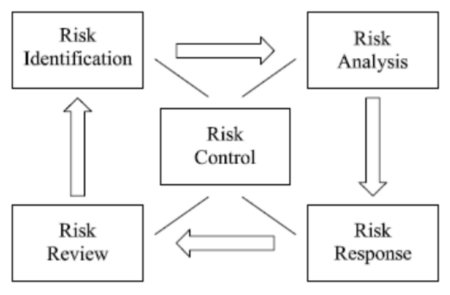Pro-active: Risk and Opportunity Management
Contents |
Abstract
Pro-active risk and opportunity management considers risk and opportunity events in a project with the purpose of mitigating the risk and enhance the opportunities before they occur. Risk events occur from uncertainties within a project whereas negative outcome is a risk for the project but positive outcomes can become opportunities for the stakeholders of the project.
A process/model to gain risk control for a pro-active risk and opportunity management is first identifying risks then assess the risks and last treat the risks which result in risk control. There is a fouth step to the process giving after treatment the risk management will be reviewed for analysing the success rate of the risk response/treatment.
Risk as deffinition is proberbility P times the impact I giving the formula:

Therefore is key elements in risk management the proberbility and impact that the events will occur and have. For pro-active risk management the key is then to manage these two values, done with different models and methods described further in the article, with the outcome of mitigated risk and enhanced opportunity events.
Introduction
For risk management there is in general four stages to ensure risk control the process is shown on figure 1. The four risk stages that form the risk control will be analysed with the perspective of pro-active risk and opportunity management.

For the first face in risk control the identification of the subject/risk event must be specified hereby will identify risks be analysed.
Identify risks
The identification of risks has the purpose to determine if risk events occur whether they are positive or negative for the project. [2] For positive outcomes the event will be known as "opportunity" for the project, whereas the negative events is known as "threats" for the project. This can change the life cycle of the project process.[3] E.g. can an opportunity mitigate the time development of a certain product within the project or a delevery can be done more cost beneficial if two stakeholders within the porject collaborate. Negative outcomes of events will be seen as threats for the project this can e.g. cause cost overruns or time delays. This can be rescourse-based managers that can not produce a product because the detail drawings are delayed. The drawing department is delayed do to the client not being able to give early and precise instructions on what the product must fulfil. Hereby will the identification help risk managers to locate the problem of the delay and begin assing it. Identification analysis will only analyse where events could occur but the assesment and treatment of the events is further steps into the process of risk control. Additionally from the DS/ISO standard should the identification process involve many stakeholders within the project e.g. project customers, project manager, project team, senior managers, risk managers, clients, users etc. [3] The secound step in pro-active risk management is assesing the risks that have prior to the project been identified.
Assess risks
The assessment/analysis of the events that has been identified is to prioritize which risks/opportunities are the most severe and should be delt with immediately.[2][3] How to determine the priority is through analysis of the probability for the event occurence and the impact it will have on the project objectives. [1] Which will lead to the risk given by the formula:

Timeframe and key stakeholders risk tolerance must be considered when the impact of the risk is determined. E.g. if a risk is analysed to directly affect the client or the main investors the impact of that risk will be considered high. Compared to a risk that a resource based manager in the project could experience. This is due to the importance of the stakeholders if the investors in the project withdraw there is no funding and the project falls apart. But if a resource based manager experiences threats the worst outcome could be time delays or cost overruns this should ofcourse be mitigated as much as possible but the effect on the project is of lower importance compared to an invester withdraws.
Treat risks
The treatment considering the risks
References
- ↑ 1.0 1.1 Geraldi, Joana and Thuesen, Christian (2017) Lecture from project management MEP-4, Publisher: Technical University of Denmark
- ↑ 2.0 2.1 Geraldi, Joana and Thuesen, Christian and Stingl, Verena and Oehmen, Josef (2017) How to DO Projects? A Nordic Flavour to Managing Projects Version 1.0, Publisher: Dansk Standard
- ↑ 3.0 3.1 3.2 Guidance on project management (2013) DS/ISO 21500 Version 2.0, Publisher: Dansk Standard